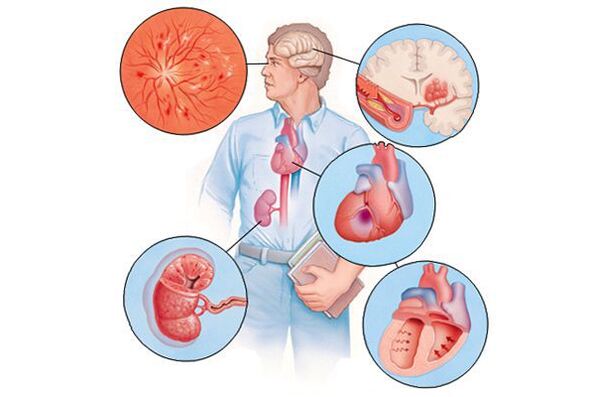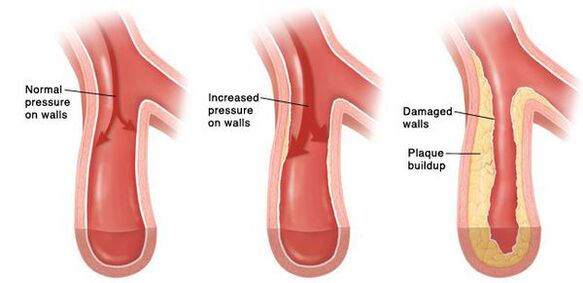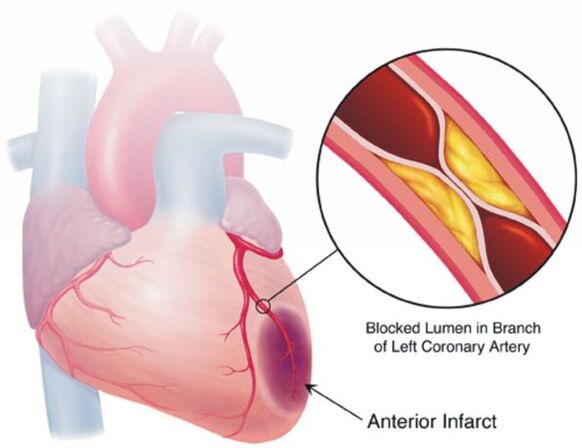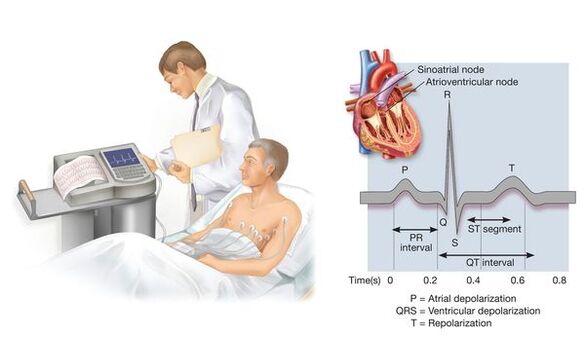The main criteriaarterial hypertension (or arterial hypertension)As a group of diseases - stable, that is, detected through repeated measurements on different days, increased blood pressure (BP).The question of what type of blood pressure is considered high is not as simple as it may seem.The fact is that among practical people, the range of blood pressure values is quite wide.The results of long-term observation of people with different levels of blood pressure show that it starts from a level of 115/75 mm Hg.Art., Every additional increase in blood pressure by 10 mm Hg.Art.accompanied by an increased risk of cardiovascular disease (especially coronary heart disease and stroke).However, the benefits of modern methods of treating arterial hypertension have been proven only for patients whose blood pressure exceeds 140/90 mmHg.Art.For this reason, it has been agreed to consider this threshold value as a criterion for identifying arterial hypertension.
Increased blood pressure can be accompanied by dozens of different chronic diseases, and hypertension is only one of them, but the most common: about 9 cases out of 10. The diagnosis of hypertension is established in cases where there is a stable increase in blood pressure, but there is no other disease that causes increased blood pressure.
Hypertension is a disease in which a stable increase in blood pressure is the main manifestation.Risk factors that increase the likelihood of its development have been established through the observation of large groups of people.In addition to the genetic predisposition some people have, these risk factors include:
- obesity;
- inactive;
- excessive use of table salt, alcohol;
- chronic stress;
- smoking
In general, all the characteristics that accompany the modern urban lifestyle in industrialized countries.This is why hypertension is considered a lifestyle disease, and targeted changes for the better should always be considered as part of a hypertension treatment program on a case-by-case basis.
What other diseases are accompanied by increased blood pressure?These are many kidney diseases (pyelonephritis, glomerulonephritis, polycystic disease, diabetic nephropathy, stenosis (narrowing) of the renal arteries, etc.), some endocrine diseases (other adrenal tumors, adjusted. The frequent use of drugs such as glucocorticosteroids, non-steroidal anti-inflammatory drugs, and oral contraceptives can also cause a persistent increase in blood pressure. The diseases and conditions listed above lead to the development of secondary arterial hypertension, or symptoms. The doctor makes a diagnosis of hypertension if, during a conversation with the patient, determines the history of the disease, examination, as well asbased on the results of several, mostly laboratory and instrumental research methods, the diagnosis of any secondary arterial hypertension seems unlikely.
If you notice similar symptoms, consult your doctor.Do not bury yourself - it is dangerous for your health!
Symptoms of arterial hypertension
High blood pressure itself does not manifest itself in any subjective sensation for many people.If high blood pressure is accompanied by symptoms, these may include a feeling of heaviness in the head, headache, flashing before the eyes, nausea, dizziness, unsteadiness when walking, as well as some other symptoms that are not specific to high blood pressure.The symptoms listed above show themselves more clearly during a hypertensive crisis - a significant increase in blood pressure, which leads to a clear deterioration in condition and well-being.
It is possible to continue to list the possible symptoms of hypertension, separated by commas, but there is no particular benefit in this.Why?First, all these symptoms are not specific for hypertension (that is, they can occur either individually or in various combinations in other diseases), and second, to establish the presence of arterial hypertension, the fact of a stable increase in blood pressure.And this is revealed not by assessing subjective symptoms, but simply by measuring blood pressure, moreover, repeatedly.This means, first, that "in one sitting" one should measure blood pressure two or three times (with a short break between measurements) and take the arithmetic mean of two or three measured values as the true blood pressure.Second, the stability of increased blood pressure (criteria for diagnosing hypertension as a chronic disease) should be confirmed by measurements on different days, preferably with an interval of at least a week.
If a hypertensive crisis develops, it will definitely be a symptom, if not, it is not a hypertensive crisis, but just an asymptomatic increase in blood pressure.And these symptoms can be either those listed above or other, more serious ones - they are discussed in the "Complications" section.
Symptomatic arterial hypertension (secondary) develops as part of another disease, and therefore their manifestation, in addition to the actual symptoms of high blood pressure (if any), depends on the underlying disease.For example, with hyperaldosteronism, this can be muscle weakness, cramps, and even paralysis (lasting hours or days) in the muscles of the legs, arms, and neck.With obstructive sleep apnea syndrome - snoring, sleep apnea, daytime sleepiness.

If hypertension over time -usually years pass to damage various organs (in this context they are called "target organs"), then this can manifest itself as a decrease in memory and intelligence, a stroke or cerebrovascular accident, an increase in thickness -which is accelerated.angina, decreased blood filtration rate in the kidneys, and so on.Therefore, clinical manifestations will be caused by this complication, and not by an increase in blood pressure as such.
Pathogenesis of arterial hypertension
In hypertension, dysregulation of vascular tone and increased blood pressure are the main content of the disease, so to speak, "quintessence".Factors such as genetic predisposition, obesity, inactivity, use of table salt, alcohol, chronic stress, smoking and several others, mainly related to lifestyle characteristics, lead over time to disruption of endothelium function - The tone of microvasculature vessels, and therefore the amount of local blood flow in organs and tissues, is autonomously controlled by the endothelium, and indirectly by the central nervous system.This is the local blood pressure regulation system.However, there are other blood pressure regulators - the central nervous system, the endocrine system and the kidneys (which are also aware of their regulatory role largely due to the ability to participate in hormonal regulation at the level of the whole organism).Violations in this complex regulatory mechanism lead, in general, to a decrease in the ability of the entire system to adapt to the ever-changing needs of organs and tissues for blood supply.

Over time, constant spasm of small arteries develops, and subsequently their walls change so much that they can no longer return to their original state.In larger vessels, due to constantly high blood pressure, atherosclerosis develops at an accelerated rate.The walls of the heart become thicker, myocardial hypertrophy develops, and then the expansion of the left atrium and left ventricle.Increased pressure damages the glomeruli, their number decreases and, as a result, the kidney's ability to filter blood decreases.In the brain, due to changes in the blood vessels that supply it, negative changes also occur - small foci of bleeding appear, as well as small areas of necrosis (death) of brain cells.When an atherosclerotic plaque ruptures in a large enough vessel, thrombosis occurs, the lumen of the vessel is blocked, and this leads to a stroke.
Classification and stages of development of arterial hypertension
Hypertension, depending on the magnitude of high blood pressure, is divided into three degrees.In addition, taking into account the increased risk of cardiovascular disease on a "decade-year" scale, already starting from blood pressure levels above 115/75 mm Hg.Art., There are several gradations of blood pressure levels.
If the systolic and diastolic blood pressure values fall into different categories, then the level of arterial hypertension is assessed by the highest of the two values, and it is not important - systolic or diastolic.The degree of increase in blood pressure when diagnosing hypertension is determined by repeated measurements on different days.
In some countries, the stages of hypertension continue to be differentiated, while the European guidelines for the diagnosis and treatment of arterial hypertension do not mention any stages.Stage identification is intended to reflect the separation of the course of hypertension from its onset to the appearance of complications.
There are three levels:
- Stage istates that there is still no obvious damage to the organs most often affected by this disease: there is no enlargement (hypertrophy) of the heart ventricles in the heart.Plaque in it is not detected, and so on.Damage to internal organs is usually asymptomatic.
- If there is at least one of the signs listed, diagnosedStage IIhypertension.
- Finally, approxLevel IIIHypertension is said when there is at least one cardiovascular disease with clinical manifestations related to atherosclerosis (myocardial infarction, stroke, angina pectoris, atherosclerotic lesions of the lower arteries), or, for example, a large loss in a significant decrease in a significant decrease in a significant decrease in a significant decrease in a significant decrease in a significant decrease in a significant decrease in the decrease and which is reduced by
These stages do not always naturally replace each other: for example, a person has a myocardial infarction, and after several years an increase in blood pressure occurs - it turns out that such a patient immediately has stage III hypertension.The purpose of staging is primarily to assess patients according to the risk of cardiovascular complications.Treatment measures also depend on this: the higher the risk, the more intensive the treatment.When formulating a diagnosis, risk is assessed in four grades.At the same time, the -4th grading corresponds to the greatest risk.
Complications of arterial hypertension
The goal of treating hypertension is not to "lower" high blood pressure, but to maximally reduce the risk of cardiovascular and other complications in the long term, as this risk is again, when evaluated on a "decade" scale for each additional 10 mm Hg.Art.Already from the blood pressure level of 115/75 mm Hg.Art.This refers to complications such as stroke, coronary heart disease, vascular dementia (dementia), renal heart failure and chronic chronic, atherosclerotic vascular lesions in the lower leg.

Most patients with hypertension are not worried about anything at the moment, so they do not have much motivation to be treated, regularly take certain minimal medications and change their lifestyle to a healthier one.However, in the treatment of hypertension there is no one-time step that allows you to forget about this disease forever without doing anything else to treat it.
Diagnosis of arterial hypertension
With such a diagnosis of arterial hypertension, everything is usually quite simple: this only requires repeated blood pressure at the level of 140/90 mm Hg.Art.and higher.But hypertension and arterial hypertension are not the same thing: as already mentioned, an increase in blood pressure can manifest itself in several diseases, and hypertension is only one of them, although the most common.When carrying out the diagnosis, the doctor, on the one hand, must ensure that the increase in blood pressure is stable, and on the other hand, assess the possibility that the increase in blood pressure is a manifestation of arterial hypertension (secondary).
To do this, at the first stage of the diagnostic search, the doctor knows at what age blood pressure begins to rise, whether there are symptoms such as, For example, snoring with pauses in breathing during sleep, attacks of muscle weakness, unusual impurities in the urine, sudden heart attacks with sweating and headaches, etc.Some routine (performed in almost all patients with high blood pressure) diagnostic tests, together with information obtained during a conversation with a doctor, help evaluate the possibility of some forms of secondary hypertension: complete urinalysis, determination of blood concentrations of creatinine and glucose, and sometimes potassium and other electrolytes.In general, taking into account the low prevalence of arterial hypertension (about 10% of all cases), the further search for this disease as a cause of high blood pressure must have a good reason.Therefore, if at the first stage of the diagnostic search no significant data is found in favor of the secondary nature of arterial hypertension, then in the future it is assumed that the blood pressure rises due to hypertension.This judgment may occasionally be revised as new data on the patient become available.
In addition to looking for data on the possible secondary nature of the increase in blood pressure, doctors determine the presence of risk factors for cardiovascular disease (this is necessary to assess the prognosis and a more targeted search for damage to internal organs), as well as, perhaps, perhaps, those that are present in matters of cardiovascis - steps.For this purpose, in addition to talking to the patient and examining him, several diagnostic studies are performed (for example, electrocardiography, echocardiography, ultrasound examination of the neck vessels, and, if necessary, some other studies, the nature of which is determined by the medical data already obtained about the patient).

Daily blood pressure monitoring using a special compact device allows you to evaluate changes in blood pressure during the patient's normal lifestyle.This study is not required in all cases - especially, if the blood pressure measured at the doctor's appointment differs significantly from that measured at home, if it is necessary to evaluate the night blood pressure, if an episode of hypotension is suspected, and sometimes to evaluate the effectiveness of treatment.
Therefore, several diagnostic methods when examining patients with high blood pressure are used in all cases;The use of other methods is more selective, depending on the data that has been obtained about the patient, to check the assumptions made by the doctor during the initial examination.
Treatment of arterial hypertension
With regard to non-drug measures aimed at treating hypertension, the most convincing evidence has been accumulated on the positive role of reducing salt intake, reducing and maintaining body weight at this level, regular physical exercise (energy), no more than moderate alcohol consumption, as well as increasing the content of vegetables and fruits in the diet.Only all these measures are effective as part of a long-term change in an unhealthy lifestyle that leads to the development of hypertension.For example, a 5 kg weight loss causes a drop in blood pressure by an average of 4.4/3.6 mmHg.Art.- It seems like little, but in combination with the other steps listed above to improve your lifestyle, the effect can be very important.
Improving lifestyle is desirable for almost all patients with hypertension, but drug treatment is indicated, although not always, in most cases.In case of patients with increased blood pressure of 2 and 3 degrees, as well as with hypertension of any degree with high cardiovascular risk, drug treatment is mandatory. The benefits have beenshown in many clinical studies), then in grade 1 hypertension with low and moderate cardiovascular risk, the benefit of such treatment has not been proven in large clinical trials.In such situations, the possible benefit of drug therapy is assessed individually, taking into account the patient's preferences.If, despite improving the lifestyle, the increase in blood pressure in the patient persists for several months during repeated visits to the doctor, it is necessary to re-evaluate the need for the use of medication.In addition, the magnitude of the calculated risk often depends on the completeness of the patient's examination and may turn out to be much higher than initially thought.In almost all cases of hypertension treatment, they strive to achieve stabilization of blood pressure below 140/90 mmHg.Art.This does not mean that in 100% of the measurements it will be below these values, but the less often the blood pressure, when measured under standard conditions (described in the "Diagnostics" section), exceeds this threshold, the better.Thanks to this treatment, the risk of cardiovascular complications is significantly reduced, and hypertensive crises, if they occur, are less common than without treatment.Thanks to modern medicine, the negative processes that, in hypertension, cannot be avoided and destroy the internal organs over time (especially the heart, brain and kidneys), these processes are slowed down or suspended, and in some cases they can be reversed.
Of the drugs for the treatment of hypertension, the main ones are 5 classes of drugs:
- diuretics (diuretics);
- calcium antagonists;
- angiotensin enzyme inhibitors (names ending in -adj);
- Angiotensin II receptor antagonists (names ending in -sartan);
- Beta blockers.
Recently, the role of the first four drug classes in the treatment of hypertension has been emphasized.Beta blockers are also used, but mainly when their use is required by concomitant diseases - in this case, beta blockers serve a dual purpose.
Nowadays, preference is given to a combination of drugs, because treatment with any one of them rarely leads to achieving the desired blood pressure level.There are also combinations of drugs that make the treatment easier, because the patient only takes one tablet instead of two or even three.The selection of the class of drugs required for a particular patient, as well as the dosage and frequency of their administration, is carried out by the doctor, taking into account such data about the patient as the level of blood pressure, concomitant diseases, etc.
Thanks to the positive effects of various modern drugs, the treatment of hypertension involves not only lowering blood pressure as such, but also protecting internal organs from the negative effects of the processes that accompany high blood pressure.In addition, since the main goal of treatment is to minimize the risk of complications and increase life expectancy, it may be necessary to correct the level of cholesterol in the blood, take drugs that reduce the risk of blood clotting (which leads to myocardial infarction or stroke. and slow down the growth of atherosclerotic plaques in the blood vessels. Therefore, treating hypertension involves dealing with this disease in many ways, and achieving normal blood pressure is only one of them.
Forecast.Prevention
The overall prognosis is determined not only and not so much by the fact of high blood pressure, but by the number of risk factors for cardiovascular disease, their severity and the duration of negative effects.
These risk factors are:
- smoking;
- increased blood cholesterol levels;
- high blood pressure;
- obesity;
- sedentary lifestyle;
- age (with each decade of life after 40 years, the risk increases);
- male gender and others.
In this case, not only the intensity of exposure to risk factors is important (for example, smoking 20 cigarettes a day is undoubtedly better than 5 cigarettes, although both are associated with a worse prognosis), but also the duration of their exposure.For people who do not have obvious cardiovascular disease other than hypertension, the prognosis can be assessed using a special electronic calculator, one of which takes into account gender, age, blood cholesterol levels, blood pressure and smoking.The electronic score calculator is suitable for estimating the risk of death from cardiovascular disease in the next 10 years from the date of the risk assessment.At the same time, the risk obtained in most cases, which is low in absolute numbers, can produce a misleading effect, because the calculator allows you to calculate the risk of cardiovascular death.The risk of non-fatal complications (myocardial infarction, stroke, angina pectoris, etc.) is many times higher.The presence of diabetes mellitus increases the risk compared to that calculated using the calculator: for men by 3 times, and for women - even 5 times.
Regarding the prevention of hypertension, we can say that because the risk factors for its development are known (inactivity, overweight, chronic stress, lack of regular sleep, alcohol abuse, increased use of table salt, etc.), then all lifestyle changes that reduce the effects of these factors also reduce the risk of developing hypertension.However, it is not possible to completely reduce this risk to zero - there are factors that do not depend on us at all or depend a little on us: genetic characteristics, gender, age, social environment, and several others.The problem is that people start thinking about prevention of hypertension especially when they are already unwell, and blood pressure has already increased to one degree or another.And this is not a question of prevention as much as treatment.

















